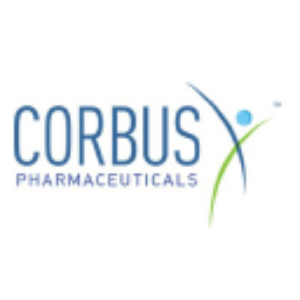Corbus Pharmaceuticals Announces Topline Results from DETERMINE Phase 3 Study of Lenabasum for Treatment of Dermatomyositis
Rhea-AI Summary
Corbus Pharmaceuticals (NASDAQ: CRBP) announced the topline results of its Phase 3 DETERMINE study on lenabasum for treating dermatomyositis. The study failed to meet its primary endpoint of Total Improvement Score (TIS) at Week 28, with lenabasum achieving a mean TIS of 28.3 versus 26.7 in the control group (p = 0.1965). However, nominally significant improvements were noted in subtypes of the disease. Lenabasum was found to be safe and well-tolerated. The findings will be discussed with regulatory authorities as the company looks to explore next steps.
Positive
- Nominally significant improvement in TIS (p = 0.0302) for classic dermatomyositis subtype.
- Safe and well-tolerated treatment profile with no discontinuations due to drug-related adverse effects.
- Encouraging results in CDASI scores indicating effectiveness for skin involvement.
- Strong cash position allowing continued advancement of diversified pipeline.
Negative
- Did not meet the primary endpoint of TIS at Week 28, signaling potential efficacy concerns.
- No statistically significant improvement in lung function compared to the control group.
News Market Reaction 1 Alert
On the day this news was published, CRBP gained 4.02%, reflecting a moderate positive market reaction.
Data tracked by StockTitan Argus on the day of publication.
- Study did not meet primary endpoint of Total Improvement Score (TIS) at Week 28
- Additional findings included nominally significant improvements in TIS (p = 0.0302) and CDASI (p = 0.0166) depending on the dermatomyositis subtype
- Lenabasum treatment was safe and well-tolerated in this study
Norwood, MA, June 24, 2021 (GLOBE NEWSWIRE) -- Corbus Pharmaceuticals Holdings, Inc. (NASDAQ: CRBP) (“Corbus” or the “Company”), an immunology company developing innovative medicines that target inflammation, fibrosis, metabolism and immuno-oncology, today announced topline results from the Phase 3 DETERMINE study of lenabasum in adults with the rare, heterogeneous, autoimmune disease dermatomyositis.
Primary endpoint:
The study did not meet its primary endpoint of Total Improvement Score (TIS) at Week 28. Higher TIS values indicate greater overall improvement. At Week 28, the lenabasum 20 mg twice daily group achieved a mean TIS of 28.3 versus the control group mean TIS of 26.7, p = 0.1965. All subjects, including the control group, received standard background treatments, with
Additional findings:
Dermatomyositis patients have characteristic muscle weakness and inflammatory skin involvement. This study enrolled subjects with the two major types of dermatomyositis: classic dermatomyositis with both muscle weakness and skin involvement and dermatomyositis with no significant muscle weakness but with skin involvement. Improvement in muscle weakness is heavily weighted in the TIS score. In the overall study, higher TIS scores were seen in those subjects who had muscle weakness (Manual Muscle Test-8 muscle group score < 142) and were treated with lenabasum 20 mg twice daily versus the control group, nominal p = 0.0302. Conversely, the Cutaneous Dermatomyositis Activity and Severity Index (CDASI) activity score, a secondary endpoint in this study, is a validated outcome that was designed to assess inflammatory skin involvement in dermatomyositis. In the overall study, greater improvement (reduction) in CDASI activity scores was seen in subjects with skin involvement but no muscle weakness who were treated lenabasum 20 mg twice daily versus the control group, nominal p = 0.0166. This is a similar patient population and the same endpoint as was tested in Corbus’ previously completed Phase 2 study (ClinicalTrials.gov Identifier: NCT02466243).
Effect of lenabasum on lung function was a secondary endpoint in this study, and no statistically significant difference was seen at Week 28 in the lenabasum 20 mg twice daily group versus control group. In the overall study, other pre-specified analyses showed that subjects on stable immunosuppressive therapies (> 1 year treatment duration) had an improvement in forced vital capacity compared to the control group, nominal p = 0.0591.
Efficacy results for the lenabasum 5 mg twice daily group were generally similar to those for the control group.
Safety:
Safety data showed
Data from this study will be presented at an upcoming medical conference.
“We are disappointed that the trial did not meet the primary endpoint of TIS at Week 28,” said Barbara White, M.D., Chief Medical Officer and Head of Research at Corbus. “Nonetheless, we are encouraged by the results when the outcome is matched to the subtype of dermatomyositis in the study. We believe we see clinical activity of lenabasum 20 mg administered twice daily compared to the control group just receiving standard background treatments, with higher TIS scores in classic dermatomyositis subjects with muscle weakness and skin involvement and greater reduction in CDASI activity score in subjects with active skin disease but normal muscle strength. We thank the participants, investigators and clinical site study staff, and the patient advocacy community for their support of this study.”
Victoria Werth, M.D., Professor of Dermatology and Medicine, University of Pennsylvania Perelman School of Medicine and Chief of Dermatology, Corporal Michael J. Crescenz VAMC, said, “I’m pleased by the improvement in CDASI activity scores seen in dermatomyositis patients with minimal active muscle disease in this study. It is difficult to conduct a large stand-alone study in just this small subtype of patients. In such a complex disease, seeing this subtype with refractory skin disease respond so well in this and the Phase 2 study is promising. These patients frequently have widespread disfiguring, symptomatic and refractory skin manifestations, and there is a need for new treatments, especially those that are not immunosuppressive. Our skin biomarker data from Phase 2 show reductions in inflammatory cytokines and T cells with lenabasum treatment compared to placebo, supporting improvement in skin disease in these patients. The improvement in TIS in subjects with muscle weakness is also interesting. It is clear to me that we have to look at the organs that are involved and use outcomes that correspond to those organs to detect change in dermatomyositis.”
Yuval Cohen, Ph.D., Chief Executive Officer, commented, “We look forward to discussing the data from the Phase 2 and Phase 3 dermatomyositis studies with regulatory authorities and seeking their input on next steps. With our strong cash position, we have the resources to both advance our now diversified pipeline while also planning next steps for lenabasum.”
DETERMINE Phase 3 Study Design
The Phase 3 trial evaluated the safety and efficacy of lenabasum in adults with active classic or amyopathic dermatomyositis who were receiving standard treatments. This international study dosed 175 subjects who were randomized 2:1:2 to receive lenabasum 20 mg twice per day (n = 69), lenabasum 5 mg twice per day (n = 35), or placebo twice per day (n = 71), all added to background treatments. The primary efficacy endpoint was the composite American College of Rheumatology/European League Against Rheumatism 2016 Total Improvement Score at Week 28, comparing lenabasum 20 mg twice daily versus placebo. Change in CDASI activity score and forced vital capacity were among secondary efficacy endpoints. As previously disclosed, in this study of up to one year duration, the timing of the primary efficacy endpoint was changed from Week 52 to Week 28.
About Lenabasum
Lenabasum is a novel, oral, small molecule designed to provide an alternative to immunosuppressive treatments for inflammatory or fibrotic diseases. Lenabasum binds to and activates the cannabinoid receptor type 2 (CB2), which is preferentially expressed on activated immune cells, to resolve inflammation and limit fibrosis. Data from animal models and human clinical studies suggest that lenabasum can reduce expression of genes and proteins involved in inflammation and fibrosis. In clinical testing to date, lenabasum has acceptable safety and tolerability profiles.
About Dermatomyositis
Dermatomyositis, a form of idiopathic inflammatory myositis, is a chronic, rare, inflammatory, clinically heterogenous, and sometimes life-threatening autoimmune disease affecting approximately 80,000 people in North America, EU and Japan.1 The signs and symptoms of dermatomyositis reflect multi-organ involvement, which includes distinctive skin rashes usually accompanied by proximal muscle weakness, and can also include pulmonary, cardiac, gastrointestinal, and joint involvement.2 Patients with dermatomyositis can have recurrent disease flares or chronic progressive disease activity, with increased mortality.3,4 The current mainstay of treatments include FDA-approved systemic glucocorticoids and off-label use of glucocorticoid-sparing immunosuppressive or immunomodulating agents.5,6 There is significant unmet need for new treatments to achieve disease control in dermatomyositis because of limited efficacy or toxicity of immunosuppressive agents or refractory disease.7,8
About Corbus
Corbus is committed to connecting innovation to our purpose of improving lives by developing new medicines that target inflammation, fibrosis, metabolism and immuno-oncology, by building upon our underlying expertise in immunology. Corbus’ current pipeline includes small molecules that activate or inhibit the endocannabinoid system and anti-integrin monoclonal antibodies that block activation of TGFβ. Corbus is headquartered in Norwood, Massachusetts. For more information on Corbus, visit corbuspharma.com. Connect with us on Twitter, LinkedIn and Facebook.
Forward-Looking Statements
This press release contains certain forward-looking statements within the meaning of Section 27A of the Securities Act of 1933 and Section 21E of the Securities Exchange Act of 1934 and Private Securities Litigation Reform Act, as amended, including those relating to the Company's restructuring, trial results, product development, clinical and regulatory timelines, market opportunity, competitive position, possible or assumed future results of operations, business strategies, potential growth opportunities and other statement that are predictive in nature. These forward-looking statements are based on current expectations, estimates, forecasts and projections about the industry and markets in which we operate and management's current beliefs and assumptions.
These statements may be identified by the use of forward-looking expressions, including, but not limited to, "expect," "anticipate," "intend," "plan," "believe," "estimate," "potential,” "predict," "project," "should," "would" and similar expressions and the negatives of those terms. These statements relate to future events or our financial performance and involve known and unknown risks, uncertainties, and other factors, including the potential impact of the recent COVID-19 pandemic and the potential impact of sustained social distancing efforts, on our operations, clinical development plans and timelines, which may cause actual results, performance or achievements to be materially different from any future results, performance or achievements expressed or implied by the forward-looking statements. Such factors include those set forth in the Company's filings with the Securities and Exchange Commission. Prospective investors are cautioned not to place undue reliance on such forward-looking statements, which speak only as of the date of this press release. The Company undertakes no obligation to publicly update any forward-looking statement, whether as a result of new information, future events or otherwise.
Corbus Pharmaceuticals Contacts:
Ted Jenkins, Senior Director, Investor Relations and Corporate Communications
Phone: +1 (617) 415-7745
Email: ir@corbuspharma.com
Lindsey Smith, Director, Investor Relations and Corporate Communications
Phone: +1 (617) 415-7749
Email: mediainfo@corbuspharma.com
- Health Advances, LLC Analysis
- “Dermatomyositis Information Page.” National Institute of Neurological Disorders and Stroke, U.S. Department of Health and Human Services, 23 June 2021, www.ninds.nih.gov/Disorders/All-Disorders/Dermatomyositis-Information-Page
- Marie, Isabelle. “Morbidity and Mortality in Adult Polymyositis and Dermatomyositis.” Current Rheumatology Reports, vol. 14, no. 3, 2012, pp. 275–285., doi:10.1007/s11926-012-0249-3
- Schiopu, Elena, et al. “Predictors of Survival in a Cohort of Patients with Polymyositis and Dermatomyositis: Effect of Corticosteroids, Methotrexate and Azathioprine.” Arthritis Research & Therapy, vol. 14, no. 1, 2012, doi:10.1186/ar3704
- FDA label Orapred ODT, available at https://www.accessdata.fda.gov/drugsatfda_docs/label/2010/021959s004lbl.pdf; accessed 23 June 2021
- FDA label H.P. Acthar gel, available at https://www.accessdata.fda.gov/drugsatfda_docs/label/2018/008372s057lbl.pdf; accessed 23 June 2021
- Dalakas, Marinos C. “Immunotherapy of Myositis: Issues, Concerns and Future Prospects.” Nature Reviews Rheumatology, vol. 6, no. 3, Mar. 2010, pp. 129–137., doi:10.1038/nrrheum.2010.2
- DeWane ME, et al. Dermatomyositis: Clinical features and pathogenesis. J Am Acad Dermatol.






